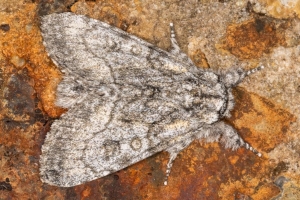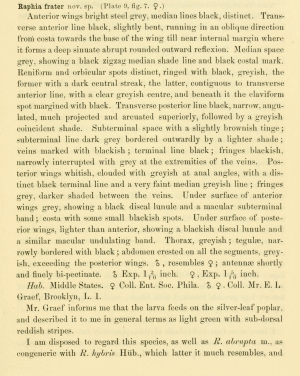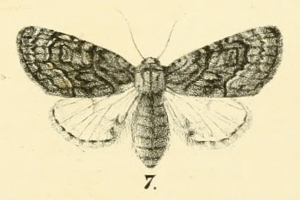3. Biologie
3.1. Nahrung der Raupe
- [Salicaceae:] Populus tremuloides (Amerikanische Espe, Amerikanische Zitter-Pappel)
- [Salicaceae:] Populus grandidentata (Großzähnige Pappel)
- [Salicaceae:] Populus alba (Silber-Pappel)
- [Salicaceae:] Populus nigra (Schwarz-Pappel)
- [Salicaceae:] Populus x canadensis (Kanadische Hybrid-Pappel)
- [Salicaceae:] Populus balsamifera (Balsam-Pappel)
- [Salicaceae:] Populus trichocarpa (Westliche Balsam-Pappel)
- [Salicaceae:] Populus sp. (Pappel)
- [Salicaceae:] Populus sp. (Pappel)
- [Salicaceae:] Populus sp. (Pappel)
- [Salicaceae:] Salix sp. (Weide)
- [Betulaceae:] Alnus incana ??? (Grau-Erle ???)
- [Betulaceae:] Betula papyrifera ??? (Papier-Birke ???)
Die Raupe lebt in erster Linie - oder ausschließlich - an Pappeln. In der Erstbeschreibung von Grote (1864: 435) ist zu erfahren: "Mr. Graef informs me that the larva feeds on the silver-leaf poplar, and described it to me in general terms as light green with subdorsal reddish stripes."
Schmidt & Anweiler (2014) bringen das Verbreitungsgebiet der ssp. frater weitgehend mit Populus tremuloides und Populus grandidentata. Das Verbreitungsgebiet der ssp. abrupta deckt sich demnach mit dem Vorkommen von Populus deltoides, ssp. elbea ist meist mit Vorkommen von Populus fremonti verbunden, ssp. coloradensis hingegen mit Populus angustifolia und Populus deltoides. Alle diese Pappeln kommen hier also auch als Freiland-Raupennahrung in Frage. Die Autoren vermerken allerdings: "72% of the 132 larval collections of R. frater from across Canada summarized by Prentice (1962) came from trembling aspen, 17% from other Populus species (P. balsamifera L., P. trichocarpa Torr. & Gray, P. grandidentata, P. ‘× canadensis’ (Alt.), P. nigra L. var. italica du Roi), and 3% from Salix spp. Three records from white birch and one from alder (both Betulaceae) reported by Prentice are exceptional and possibly accidental. Wagner et al. (2011) consider Populus to be the main hosts, and question the validity of records from birch and alder."
4. Weitere Informationen
4.1. Synonyme
- Certila flexuosa Walker, 1865
- Saligena personata Walker, 1865
- Raphia personata (Walker, 1865)
- Raphia pallula H. Edwards, 1886
- Raphia cinderella Smith, 1903
- Raphia elbea Smith, 1908
- Raphia piazzi Hill, 1927
4.2. Faunistik
Grote (1864: 435) beschrieb seine Art aus den "Middle States" in den USA. Nach Schmidt & Anweiler (2014) ist sie in einer Reihe von Subspezies von Kanada - quer durch die gesamte USA - bis in den Norden Mexikosa verbreitet.
Die Art ist in Europa sicher nicht etabliert. Agassiz et al. (2013: 123) führen sie bei den "adventive species" und schreiben zu England: "One at light Rothamsted, Hertfordshire, 1949. North American."
(Autor: Erwin Rennwald)
4.3. Literatur
- Agassiz, D.J.L., Beavan, S.D. & R.J. Heckford (2013): Checklist of the Lepidoptera of the British Isles. - Royal Entomological Society. 206pp.
- Erstbeschreibung: Grote, A. R. (1864): Descriptions of North American Lepidoptera – no. 2. — Proceedings of the Entomological Society of Philadelphia, 2: 433–441. [Digitalisat auf biodiversitylibrary.org]
- Schmidt, B.C. & G.G. Anweiler (2014): Taxonomy and biogeography of the Nearctic Raphia Hübner (Lepidoptera, Noctuidae, Raphiinae). — 91-113. In: Schmidt, B.C. & J.D. Lafontaine [Eds.] (2014): Contributions to the systematics of New World macromoths V. — ZooKeys, 421: 192 pp. doi: 10.3897/zookeys.421.7517. [zum PDF-Download auf ZooKeys.net]




![Einzelnachweis in Großbritannien [1949 einmal nach Rothamsted verschleppt]](/res/img/flag/gb.gif)
![Vorkommen in den Vereinigten Staaten von Amerika (USA) [locus typicus: "Middle States"]](/res/img/flag/us.gif)








